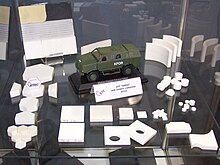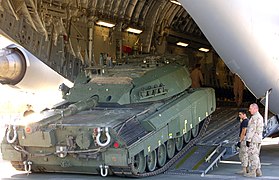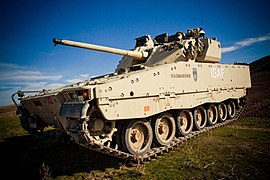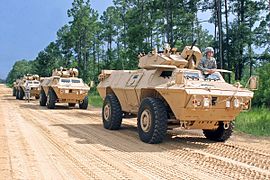
Composite armour is a type of vehicle armour consisting of layers of different materials such as metals, plastics, ceramics or air. Most composite armours are lighter than their all-metal equivalent, but instead occupy a larger volume for the same resistance to penetration. It is possible to design composite armour stronger, lighter and less voluminous than traditional armour, but the cost is often prohibitively high, restricting its use to especially vulnerable parts of a vehicle. Its primary purpose is to help defeat high-explosive anti-tank (HEAT) projectiles.
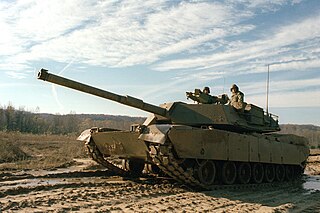
Chobham armour is the informal name of a composite armour developed in the 1960s at the Military Vehicles and Engineering Establishment, a British tank research centre on Chobham Lane in Chertsey. The name has since become the common generic term for composite ceramic vehicle armour. Other names informally given to Chobham armour include Burlington and Dorchester. Special armour is a broader informal term referring to any armour arrangement comprising sandwich reactive plates, including Chobham armour.

The Stryker is a family of eight-wheeled armored fighting vehicles derived from the Canadian LAV III. Stryker vehicles are produced by General Dynamics Land Systems-Canada (GDLS-C) for the United States Army in a plant in London, Ontario. It has four-wheel drive (8×4) and can be switched to all-wheel drive (8×8).

The M113 is a fully tracked armored personnel carrier (APC) that was developed and produced by the FMC Corporation. The M113 was sent to United States Army Europe in 1961 to replace the mechanized infantry's M59 APCs. The M113 was first used in combat in April 1962 after the United States provided the South Vietnamese army (ARVN) with heavy weaponry such as the M113, under the Military Assistance Command, Vietnam (MACV) program. Eventually, the M113 was the most widely used armored vehicle of the U.S. Army in the Vietnam War and was used to break through heavy thickets in the midst of the jungle to attack and overrun enemy positions. It was largely known as an "APC" or an "ACAV" by the allied forces.

The Leopard 2 is a third generation German main battle tank (MBT). Developed by Krauss-Maffei in the 1970s, the tank entered service in 1979 and replaced the earlier Leopard 1 as the main battle tank of the West German army. Various iterations of the Leopard 2 continue to be operated by the armed forces of Germany, as well as 13 other European countries, and several non-European countries, including Canada, Chile, Indonesia, and Singapore. Some operating countries have licensed the Leopard 2 design for local production and domestic development.

Military vehicles are commonly armoured to withstand the impact of shrapnel, bullets, shells, rockets, and missiles, protecting the personnel inside from enemy fire. Such vehicles include armoured fighting vehicles like tanks, aircraft, and ships.

The Bionix (BX) is a family of tracked Singaporean armoured fighting vehicles developed by ST Kinetics. Intended to augment the Singapore Army's aging M113 armoured personnel carriers, it is the first indigenous armoured vehicle to be developed in Southeast Asia. The Bionix has been operational with the Singapore Armed Forces (SAF) since 1999 in a wide variety of adaptations including the Bionix II, Bionix 25 and Bionix 40/50 variants.

The TPz Fuchs from Transportpanzer Fuchs is a German armoured personnel carrier originally developed by Daimler-Benz, and manufactured and further developed by the now Rheinmetall MAN Military Vehicles (RMMV). Fuchs was the second wheeled armoured vehicle to enter service with the Bundeswehr. It can be used for tasks including troop transport, engineer transport, bomb disposal, Nuclear, Biological and Chemical reconnaissance and electronic warfare. RMMV and its predecessors manufactured 1,236 Fuchs 1, mostly for the German Army.

The ASCOD armoured fighting vehicle family is the product of a cooperation agreement between Austrian Steyr-Daimler-Puch AG and Spanish General Dynamics Santa Bárbara Sistemas. Both companies are now divisions of a unit of General Dynamics. The ASCOD family includes the LT 105 light tank equipped with a 105 mm gun, a surface-to-air missile launcher, an anti-tank guided missile launcher, mortar carrier, R&R vehicle, command-and-control vehicle, ambulance, artillery observer, and the AIFV model.

Armour with two or more plates spaced a distance apart falls under the category of spaced armour. Spaced armour can be sloped or unsloped. When sloped, it reduces the penetrating power of bullets and solid shot, as after penetrating each plate projectiles tend to tumble, deflect, deform, or disintegrate; spaced armour that is not sloped is generally designed to provide protection from explosive projectiles, which detonate before reaching the primary armour. Spaced armour is used on military vehicles such as tanks and combat bulldozers. In a less common application, it is used in some spacecraft that use Whipple shields.

The M1117 Guardian, also denoted Armored Security Vehicle (ASV), is an internal security vehicle based on the V-100 and V-150 Commando series of armored cars. It was developed in the late 1990s for service with the United States' Military Police Corps. The first prototypes appeared in February 1997 and serial production of the M1117 commenced between 1999 and early 2000.

The K21 is a South Korean infantry fighting vehicle. A replacement for the K200-series, it was formerly designated as K300 or XK21 KNIFV. The initial production began in 2009, with the Republic of Korea Army planning to field approximately 466 units. It is designed to effectively defeat other IFVs as heavily armed and armored as the BMP-3.
A huge number of M113 Armored Personnel Carrier variants have been created, ranging from infantry carriers to nuclear missile carriers. The M113 armored personnel carrier has become one of the most prolific armored vehicles of the second half of the 20th century, and continues to serve with armies around the world in many roles.

Stridsvagn 122 is a Swedish main battle tank that, like the German Leopard 2A5, is based on the German Leopard 2 improved variant utilizing such newer technology as command, control, and fire-control systems, reinforced armour, and long-term combat capacity. Externally, the vehicle is distinguished from the Leopard 2A5 by the French GALIX smoke dispensers, different storage bins, and the thicker crew hatches.

The ATF Dingo is a German heavily armored military MRAP infantry mobility vehicle based on a Unimog chassis with a V-hull design, produced by the company Krauss-Maffei Wegmann (KMW). The first prototype of the Dingo 1 was completed in 1995 and the first production Dingo 1 entered service in 2000 with the German Army. It is designed to withstand land mines, rifle fire, artillery fragments and NBC-threats. ATF stands for Allschutz-Transport-Fahrzeug, meaning all-protected transport vehicle in German. It is named after the Australian native dog, the dingo. The Dingo 2 entered service in late 2004 after undergoing trials from November 2003-May 2004. Currently KMW is developing the Dingo 2 GFF for the German Army with increased internal volume.

Slat armor, also known as bar armor, cage armor, and standoff armor, is a type of vehicle armor designed to protect against high-explosive anti-tank (HEAT) attacks, as used by anti-tank guided missiles (ATGMs) and rocket-propelled grenades (RPGs).
Advanced Modular Armor Protection (AMAP) is modular composite armour concept, developed by the German company IBD Deisenroth Engineering. According to IBD AMAP is a 4th generation composite armour, making use of nano-ceramics and modern steel alloy technologies. AMAP is the successor of MEXAS.
AMAP-ADS is a hard-kill active protection system (APS), developed by the German company ADS Gesellschaft für aktive Schutzsysteme, a subsidiary of Rheinmetall and IBD Deisenroth Engineering, as part of their Advanced Modular Armor Protection concept. The system is also known under the name AAC in Sweden and as Shark in France. Due to its modular design it can be adapted to a broad range of vehicles. In particular, it is capable of protecting light vehicles against large caliber weapons which the vehicles' light armor wouldn't stop.
IBD Deisenroth Engineering was a German company specializing in the design of armor for military vehicles. They formed in 1981 to develop applications of a new explosive suitable for use in explosive reactive armor (ERA). Through the 1980s, they developed many individual applications for the Bundeswehr. In 1994, they introduced their MEXAS armor systems using ceramic armor which were very popular as upgrade systems for a wide range of armored vehicles, mostly in NATO. MEXAS was replaced by AMAP in 2006, which includes a wide variety of modular armor, both active and passive.

The Sabrah light tank is a configuration of system solutions added to armored fighting vehicles proposed by Elbit Systems. It is designed to complement the fleet of armored fighting vehicles operated by the armed forces worldwide. The tracked light tank configuration is based on ASCOD 2 platform, supplied by Spanish manufacturer GDELS - Santa Bárbara Sistemas. The wheeled light tank configuration is based on the 8×8 Pandur II platform supplied by the Czech manufacturer Excalibur Army. Elbit Systems received a three-year contract worth $172m to supply the Sabrah light tanks to the Philippine Army in January 2021.
